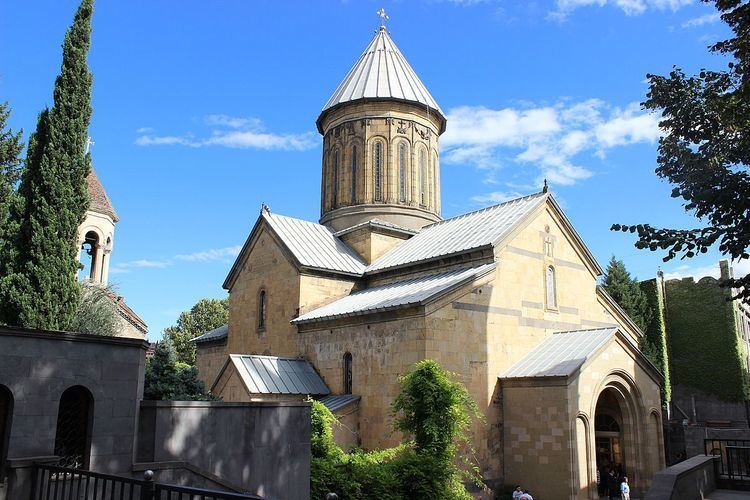Phone +995 322 98 89 53 Number of domes 1 | ||
 | ||
Completed Church: 6th-7th century,renovated 13th century and17th-18th century.Belfry: 1812 Similar Narikala, Metekhi, Anchiskhati Basilica, Svetitskhoveli Cathedral, Jvari | ||
The Sioni Cathedral of the Dormition (Georgian: სიონის ღვთისმშობლის მიძინების ტაძარი) is a Georgian Orthodox cathedral in Tbilisi, the capital of Georgia. Following a medieval Georgian tradition of naming churches after particular places in the Holy Land, the Sioni Cathedral bears the name of Mount Zion at Jerusalem. It is commonly known as the "Tbilisi Sioni" to distinguish it from several other churches across Georgia bearing the name Sioni.
Contents
The Tbilisi Sioni Cathedral is situated in historic Sionis Kucha (Sioni Street) in downtown Tbilisi, with its eastern façade fronting the right embankment of the Kura River. It was initially built in the 6th and 7th centuries. Since then, it has been destroyed by foreign invaders and reconstructed several times. The current church is based on a 13th-century version with some changes from the 17th to 19th centuries. The Sioni Cathedral was the main Georgian Orthodox Cathedral and the seat of Catholicos-Patriarch of All Georgia until the Holy Trinity Cathedral was consecrated in 2004.
History
According to medieval Georgian annals, the construction of the original church on this site was initiated by King Vakhtang Gorgasali in the 5th century. A hundred years later, Guaram, the prince of Iberia (Kartli), in c. 575 began building a new structure, which was completed by his successor Adarnase in circa 639. According to legend, both princes were buried in this church, but no trace of their graves has been found. This early church was completely destroyed by Arabs, and was subsequently built de novo.
The cathedral was completely rebuilt by King David the Builder in 1112. The basic elements of the existing structure date from this period. It was heavily damaged in 1226, when its dome was ruined on the order of Jalal ad Din Mingburnu. It was subsequently repaired, but damaged again by Timur in 1386 and repaired by King Alexander I. It was again damaged during the Persian invasion in the 17th century.
In 1657, the Metropolitan of Tbilisi, Elise Saginashvili (died 1670), substantially restored the cupola and added the southern chapel, but the structure was again devastated in 1668, this time by earthquake. The regent of Kartli, batonishvili (prince) Vakhtang, carried out restorations of the cupola and cathedral walls in 1710. However, the church was again damaged by the invasion of the Persians in 1795.
The cathedral's interior took on a different look between 1850 and 1860, when the Russian artist and general Knyaz Grigory Gagarin (1810–1893) composed an interesting series of the murals, though a number of medieval frescoes were lost in the process. A portion of the murals on the western wall were executed by the Georgian artist Levan Tsutskiridze in the 1980s.
The stone iconostasis dates to the 1850s. It replaced the wooden iconostasis burned during the Persian invasion in 1795. To the left of the altar is the venerated Grapevine cross which, according to tradition, was forged by Saint Nino, a Cappadocian woman who preached Christianity in the Caucasus in the early 4th century. King Vakhtang III gave the reliquary itself in the early 14th century.
The Sioni Cathedral was where the Russian Imperial manifesto on the annexation of Georgia was first published. On April 12, 1802 the Russian commander-in-chief in Georgia, General Karl von Knorring, assembled the Georgian nobles in the Cathedral, which was then surrounded by Russian troops. The nobles were forced to take an oath to the Russian Imperial crown; any who disagreed were taken into custody.
Sioni Cathedral remained functional through Soviet times, and was partially renovated between 1980 and 1983.
Architecture
The Sioni Cathedral is a typical example of medieval Georgian church architecture of an inscribed cross design with projecting polygonal apses in the east façade. The yellow tuff from which the cathedral was built comes from Bolnisi, a town southwest of Tbilisi. The facades are simple, with few decorations, although there are bas-relief carvings of a cross and a chained lion on the western side and an angel and saints on the north. All sixteen windows have carved ornamental frames.
North of the cathedral, within the courtyard, is a freestanding three-story bell tower dating from the 1425 reconstruction by King Alexander I. Largely destroyed by the Persians in 1795, it was restored to its present condition in 1939. Across the street stands another three-story bell tower; one of the earliest example of Russian Neoclassical architecture in the region. Complete in 1812, the bell tower was commissioned under Pavel Tsitsianov using money awarded in recognition of his conquest of Ganja for the Russian Empire.
Burials
The Sioni Cathedral serves as a burial ground for several notable churchmen, including the 20th-century Catholicoi-Patriarchs of Georgia:
